
Oryzopsis hymenoides is a cool-season, perennial bunchgrass with narrow, rolled leaf blades. It is native to western North America east of the Cascades from British Columbia and Alberta south to southern California, northeastern Mexico, and Texas. In the wild, it typically grows 4 to 24 in tall and 8 to 12 in wide.
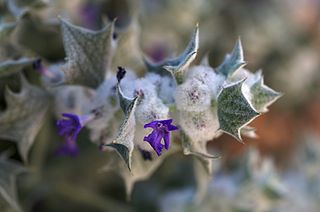
Salvia funerea, with the common names Death Valley sage, woolly sage, and funeral sage, is an intricately branched shrub associated with limestone soils in the Mojave Desert in California and Nevada. It has an overall white appearance due to wooly hairs that cover the stems and leaves.

Asclepias speciosa is a milky-sapped perennial plant in the dogbane family (Apocynaceae), known commonly as the showy milkweed, and is found in the Western half of North America.

Dalea mollissima is a desert wildflower plant in the legume family (Fabaceae), with the common names soft prairie clover, downy dalea, and silk dalea.
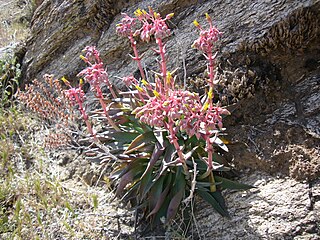
Dudleya saxosa is a perennial succulent desert plant in the family Crassulaceae, commonly called live-forever'. This dudleya is native to the rocky slopes of the Peninsular Ranges and the sky islands in Mojave Desert mountains, such as the Panamint Range, in Southern California, and in Baja California and Arizona.
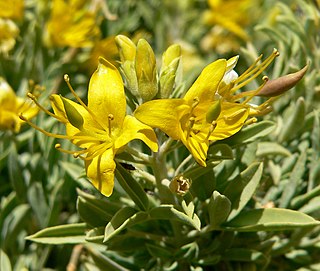
Peritoma arborea, is a perennial shrub or bush in the spiderflower family (Cleomaceae) known by the common names bladderpod, bladderpod spiderflower and burro-fat. It has yellow flowers in bloom all months of the year. It emits a foul odor to discourage herbivory from insects.

Baccharis sergiloides is a species of baccharis known by the common name desert baccharis.
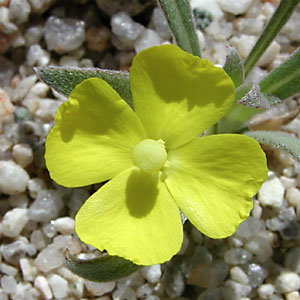
Camissoniopsis pallida is a low growing, yellow-flowered annual plant in the evening primrose family, Onagraceae. It is known by the common names pale primrose or pale yellow suncup. It is native to the desert and scrub habitat of the region where Arizona, California, and Nevada meet. It is a roughly hairy annual herb growing in a low patch on the ground, sometimes producing an erect stem from the basal rosette. The herbage is gray-green to reddish green. The leaves are lance-shaped and up to 3 centimeters long. The nodding inflorescence produces flowers with yellow petals 2 to 13 millimeters long, each with small red markings near the bases. The fruit is a straight to tightly coiled capsule.

Dasyochloa is a monotypic genus containing the single species Dasyochloa pulchella, known as desert fluff-grass or low woollygrass, a densely tufted perennial grass found in the deserts of the southwestern United States.
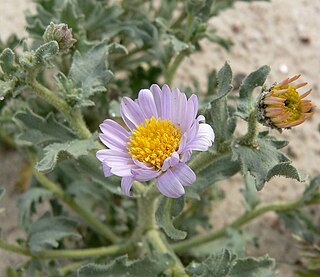
Arida arizonica,, is an annual plant in the, known by the common names arid tansyaster, desert tansyaster, and Silver Lake daisy. It is native to the very arid deserts of northern Mexico and the southwestern United States, and usually looks straggly and not very attractive. But in years with very heavy rainfall, it fills out and becomes rounded and bush like.

Dieteria canascens is an annual plant or short lived perennial plant in the daisy family, known by the common names hoary tansyaster and hoary-aster.

Menodora scabra is broom-like shrub in the Olive Family (Oleaceae), known by the common name rough menodora or broom twinberry. It is a popular desert garden plant.
Prunus eremophila, also known by its common name Mojave Desert plum, is a rare species of plum native to California.

Ambrosia salsola, commonly called cheesebush, winged ragweed, burrobush, white burrobrush, and desert pearl, is a species of perennial shrub in the sunflower family native to deserts of the southwestern United States and northwestern Mexico.
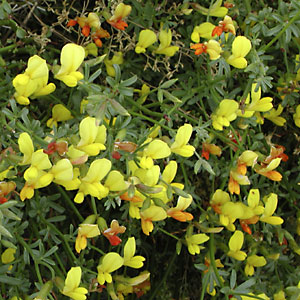
Ottleya rigida, synonyms Lotus rigidus and Acmispon rigidus, is a flowering plant in the pea family (Fabaceae), native to the southwestern United States and northwestern Mexico. It is known as shrubby deervetch or desert rock-pea. It is found in the Mojave Desert and Sonoran Desert.

Ottleya strigosa, synonyms Lotus strigosus and Acmispon strigosus, is a flowering plant in the pea family (Fabaceae), native to the southwestern United States and northern Mexico. It is known as stiff-haired lotus or strigose bird's-foot trefoil.

Aliciella latifolia, also known as broad-leaved gilia, is a foul smelling annual plant in the Phlox family (Polemoniaceae) found in deserts of the southwestern United States.
Deiandra arida, also called Red Rock tarplant, is a rare California annual plant in the.
Horsfordia alata, with the common names pink velvet mallow and pink velvetmallow, is a shrubby desert plant in the mallow family (Malvaceae).
The flora of the Colorado Plateau and Canyonlands region of the Western United States.
















